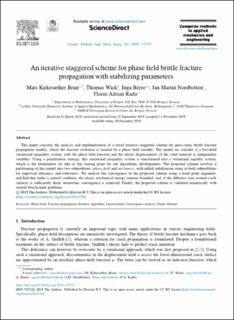| dc.contributor.author | Brun, Mats Kirkesæther | |
| dc.contributor.author | Wick, Thomas | |
| dc.contributor.author | Berre, Inga | |
| dc.contributor.author | Nordbotten, Jan Martin | |
| dc.contributor.author | Radu, Florin Adrian | |
| dc.date.accessioned | 2021-05-11T12:57:56Z | |
| dc.date.available | 2021-05-11T12:57:56Z | |
| dc.date.created | 2020-01-28T14:45:48Z | |
| dc.date.issued | 2020 | |
| dc.Published | Computer Methods in Applied Mechanics and Engineering. 2020, 361 (1), . | |
| dc.identifier.issn | 0045-7825 | |
| dc.identifier.uri | https://hdl.handle.net/11250/2754959 | |
| dc.description.abstract | This paper concerns the analysis and implementation of a novel iterative staggered scheme for quasi-static brittle fracture propagation models, where the fracture evolution is tracked by a phase field variable. The model we consider is a two-field variational inequality system, with the phase field function and the elastic displacements of the solid material as independent variables. Using a penalization strategy, this variational inequality system is transformed into a variational equality system, which is the formulation we take as the starting point for our algorithmic developments. The proposed scheme involves a partitioning of this model into two subproblems; phase field and mechanics, with added stabilization terms to both subproblems for improved efficiency and robustness. We analyze the convergence of the proposed scheme using a fixed point argument, and find that under a natural condition, the elastic mechanical energy remains bounded, and, if the diffusive zone around crack surfaces is sufficiently thick, monotonic convergence is achieved. Finally, the proposed scheme is validated numerically with several bench-mark problems. | en_US |
| dc.language.iso | eng | en_US |
| dc.publisher | Elsevier | en_US |
| dc.rights | Navngivelse 4.0 Internasjonal | * |
| dc.rights.uri | http://creativecommons.org/licenses/by/4.0/deed.no | * |
| dc.title | An iterative staggered scheme for phase field brittle fracture propagation with stabilizing parameters | en_US |
| dc.type | Journal article | en_US |
| dc.type | Peer reviewed | en_US |
| dc.description.version | publishedVersion | en_US |
| dc.rights.holder | Copyright the authors. | en_US |
| dc.source.articlenumber | 112752 | en_US |
| cristin.ispublished | true | |
| cristin.fulltext | original | |
| cristin.qualitycode | 2 | |
| dc.identifier.doi | https://doi.org/10.1016/j.cma.2019.112752 | |
| dc.identifier.cristin | 1784326 | |
| dc.source.journal | Computer Methods in Applied Mechanics and Engineering | en_US |
| dc.source.40 | 361 | |
| dc.source.14 | 1 | |
| dc.relation.project | Norges forskningsråd: 250223 | en_US |
| dc.identifier.citation | Computer Methods in Applied Mechanics and Engineering. 2020, 361, 112752. | en_US |
| dc.source.volume | 361 | en_US |

